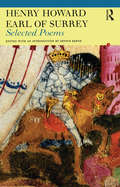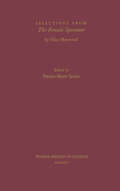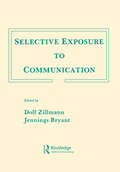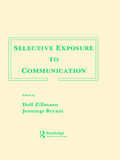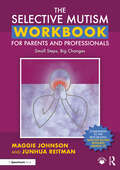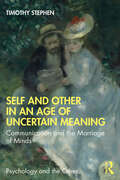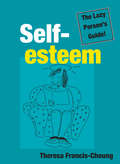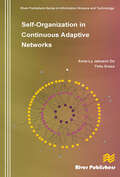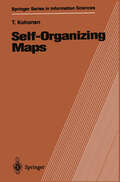- Table View
- List View
Selected Poems of Henry Howard, Earl of Surrey
by Dennis KeeneThis book is a collection of selected poems of Henry Howard, the Earl of Surrey, who is revealed as subtle and graceful poet and a translator whose vigorous and faithful versions of the Aeneid continue to enrich the literary tradition.
Selections from The Female Spectator (Women Writers in English 1350-1850)
by Eliza HaywoodAfter Aphra Behn, Eliza Haywood was the most important English female novelist of the early eighteenth century. She also edited several serial newspapers, the most important of which, the Female Spectator, was the first modern periodical written by a woman and addressed to a female audience. This fully annotated collection of articles selected from the Female Spectator includes romantic and satiric fiction, moral essays, and social commentary, covering the broad range of concerns shared by eighteenth-century middle-class women. Perhaps most compelling to a twentieth-century audience is the evidence of what we might be tempted to call feminist awareness. By no means revolutionary in her attitudes, Haywood nonetheless perceives the inequities of her periods social conditions for women. She offers pragmatic advice, such as how to avoid disastrous marriages, how to deal with wandering husbands, and what kind of education women should seek. The essays also report on a broad range of social actualities, from the craze for tea drinking and the dangers of gossip to the problem of compulsive gambling. They allude to such larger matters as politics, war, and diplomacy, and promote the importance of science and the urgency of developing informed relations with nature.
Selective Exposure To Communication (Routledge Communication Series)
by Dolf Zillmann and Jennings BryantFirst published in 1985. Routledge is an imprint of Taylor & Francis, an informa company.
Selective Exposure To Communication (Routledge Communication Series)
by Dolf Zillmann Jennings BryantFirst published in 1985. Routledge is an imprint of Taylor & Francis, an informa company.
Selective Mutism In Our Own Words: Experiences in Childhood and Adulthood
by Carl Sutton Cheryl ForresterAn eye-opening and enlightening collection of stories from people living with Selective Mutism (SM), this book provides a much-needed platform for people with SM to share experiences of the condition in their own words.Exploring all aspects of SM, from symptoms and diagnostic criteria, to triggers and the consequences of being psychologically unable to speak, the stories in this book dispel the myths around this often misunderstood condition. Far from refusing to talk, or choosing not to, the contributors offer genuine insights into why they simply cannot speak in certain situations or in front of certain people. Children, teens and adults from the UK and US share experiences of feeling isolated, struggling at school, and finding ways to communicate. Letting people with SM know that they are not alone with the condition, the book will also help family, friends and professionals to understand what it is like to live with SM.
The Selective Mutism Workbook for Parents and Professionals: Small Steps, Big Changes
by Maggie Johnson Junhua ReitmanThis workbook provides hands-on Activities, Strategies, planning sheets and progress trackers for use with children with selective mutism at home, at school and in the wider community. Written by selective mutism expert Maggie Johnson and parent coach Junhua Reitman, the workbook includes first-hand accounts of how children can overcome SM successfully using the Activities and Strategies described in this book. Activities are organised around the daily routines of school and family life and each Activity is broken into a progression of small steps with appropriate Strategies and an accompanying record sheet to track progress. Activities include: • Using the toilet at school • Attending social gatherings • Organising a successful playdate • Initiating conversation • Talking in the classroom • Eating with peers This workbook is essential reading for parents, professionals and anyone who is looking for a toolkit for selective mutism. It also provides a useful extension to The Selective Mutism Resource Manual, 2nd edition, focusing on the ‘how’ to complement the manual’s ‘what’ and ‘why’. Small steps really do lead to big changes but taking the first step can be the most difficult. This book helps you make that first step.
The Selective Mutism Workbook for Parents and Professionals: Small Steps, Big Changes
by Maggie Johnson Junhua ReitmanThis workbook provides hands-on Activities, Strategies, planning sheets and progress trackers for use with children with selective mutism at home, at school and in the wider community. Written by selective mutism expert Maggie Johnson and parent coach Junhua Reitman, the workbook includes first-hand accounts of how children can overcome SM successfully using the Activities and Strategies described in this book. Activities are organised around the daily routines of school and family life and each Activity is broken into a progression of small steps with appropriate Strategies and an accompanying record sheet to track progress. Activities include: • Using the toilet at school • Attending social gatherings • Organising a successful playdate • Initiating conversation • Talking in the classroom • Eating with peers This workbook is essential reading for parents, professionals and anyone who is looking for a toolkit for selective mutism. It also provides a useful extension to The Selective Mutism Resource Manual, 2nd edition, focusing on the ‘how’ to complement the manual’s ‘what’ and ‘why’. Small steps really do lead to big changes but taking the first step can be the most difficult. This book helps you make that first step.
Self and Other in an Age of Uncertain Meaning: Communication and the Marriage of Minds (Psychology and the Other)
by Timothy StephenSelf and Other in an Age of Uncertain Meaning explores the nature and origins of widespread problems of self in modern societies. It examines the paradoxical interplay between the modern world's many benefits and freedoms, and its mounting social challenges and psycho-emotional impacts. Over time the character of consciousness has shifted in concert with societal trends. The experienced world has become more nuanced, fragmented, and uncertain, as well as increasingly personal and intimate, reshaping social relationships. Chapters analyze the interdependence of language, mind, intimacy, the self, and culture, arguing that as the coevolution of these five factors produced the modern world, many features of contemporary culture have become disruptive to security of being. The book explores the importance to the vital sense of self in constructing relationships based in mutual recognition of moral and intellectual equality between partners.Rich with examples from everyday experience, this text offers profound insights for those interested in sociology, psychoanalysis, psychology, communication, history, and culture.
Self and Other in an Age of Uncertain Meaning: Communication and the Marriage of Minds (Psychology and the Other)
by Timothy StephenSelf and Other in an Age of Uncertain Meaning explores the nature and origins of widespread problems of self in modern societies. It examines the paradoxical interplay between the modern world's many benefits and freedoms, and its mounting social challenges and psycho-emotional impacts. Over time the character of consciousness has shifted in concert with societal trends. The experienced world has become more nuanced, fragmented, and uncertain, as well as increasingly personal and intimate, reshaping social relationships. Chapters analyze the interdependence of language, mind, intimacy, the self, and culture, arguing that as the coevolution of these five factors produced the modern world, many features of contemporary culture have become disruptive to security of being. The book explores the importance to the vital sense of self in constructing relationships based in mutual recognition of moral and intellectual equality between partners.Rich with examples from everyday experience, this text offers profound insights for those interested in sociology, psychoanalysis, psychology, communication, history, and culture.
Self-Complementary Antennas: Principle of Self-Complementarity for Constant Impedance
by Yasuto MushiakeAn antenna with a self-complementary structure has a constant input impedance, independent of the source frequency and of the shape of the structure. The principle for this property of constant impedance was discovered by Professor Mushiake himself. This is the first study which comprehensively describes the principles of self-complementarity in antennas. It explains the theory which was the basis of the development of this principle and presents various engineering applications with an emphasis on extremely broadband self-complementary antennas. Self-Complementary Antennas will be of particular interest to antenna engineers working with extremely large bandwidths and more generally to electrical engineers with an interest in the development of the field since 1948.
Self-esteem: Quick and Simple Ways to Change How You Feel About Yourself (The\lazy Person's Guide! Ser.)
by Theresa Francis-CheungChange how you think and feel about yourself – and change your life.You’ve had a glance at the vast array of self-esteem books on the shelves and been thoroughly daunted. It all seems so complicated. You don’t have time to wade through pages and pages of technical jargon, therapeutic approaches, discussions, case studies or quizzes. You don’t want to have to take up yoga or tai chi, let alone swim with dolphins or nurture your inner child. You just want to feel better about yourself – and fast!Enter The Lazy Person’s Guide! In no time at all this little guide will help you understand and improve the way you think and feel about yourself. It will give you all the essential information and advice you need and will help you change your life for the better, right now.The Lazy Person's Guide! is a series of popular, cheerful yet thoroughly grounded, practical and authoritative books on various health issues and conditions. Other titles in the series include Beating Overeating, Detox, Exercise, Improving Your Memory, Midlife, Quitting Smoking and Stress. Self-esteem: The Lazy Person’s Guide!: Table of ContentsPART ONE: Self-EsteemSelf-esteemDo you have it?Why haven’t you got it?How can you get it?PART TWO: Eight Secrets to Better Self-EsteemGet to know yourselfDon’t believe it because you think itManage your emotionsImprove your communication skillsMake decisionsTake care of yourselfManage stressEnjoy yourselfPART THREE: Extra HelpExtra help, if you need itConfidence-boosting tipsAfterword
Self-Healing Systems and Wireless Networks Management
by Junaid Ahsenali ChaudhryDo you believe in open-source development? Would you like to see your security system grow and learn by itself? Are you sick of paying for software license fees every year that produce little return on investment? And, would you prefer to invest in something you could sell later on to other IT security departments? If you answered yes to these ques
Self-Learning Speaker Identification: A System for Enhanced Speech Recognition (Signals and Communication Technology)
by Tobias Herbig Franz Gerl Wolfgang MinkerCurrent speech recognition systems are based on speaker independent speech models and suffer from inter-speaker variations in speech signal characteristics. This work develops an integrated approach for speech and speaker recognition in order to gain space for self-learning opportunities of the system. This work introduces a reliable speaker identification which enables the speech recognizer to create robust speaker dependent models In addition, this book gives a new approach to solve the reverse problem, how to improve speech recognition if speakers can be recognized. The speaker identification enables the speaker adaptation to adapt to different speakers which results in an optimal long-term adaptation.
Self-Organization in Continuous Adaptive Networks
by Anne-Ly Do Thilo GrossIn the last years, adaptive networks have been discovered simultaneously in different fields as a universal framework for the study of self-organization phenomena. Understanding the mechanisms behind these phenomena is hoped to bring forward not only empirical disciplines such as biology, sociology, ecology, and economy, but also engineering disciplines seeking to employ controlled emergence in future technologies. This volume presents new analytical approaches, which combine tools from dynamical systems theory and statistical physics with tools from graph theory to address the principles behind adaptive self-organization. It is the first class of approaches that is applicable to continuous networks. The volume discusses the mechanisms behind three emergent phenomena that are prominently discussed in the context of biological and social sciences:• synchronization,• spontaneous diversification, and• self-organized criticality.Self-organization in continuous adaptive networks contains extended research papers. It can serve as both, a review of recent results on adaptive self-organization as well as a tutorial of new analytical methodsSelf-organization in continuous adaptive networks is ideal for academic staff and master/research students in complexity and network sciences, in engineering, physics and maths.
Self-Organization in Continuous Adaptive Networks
by Anne-Ly Do Thilo GrossIn the last years, adaptive networks have been discovered simultaneously in different fields as a universal framework for the study of self-organization phenomena. Understanding the mechanisms behind these phenomena is hoped to bring forward not only empirical disciplines such as biology, sociology, ecology, and economy, but also engineering disciplines seeking to employ controlled emergence in future technologies. This volume presents new analytical approaches, which combine tools from dynamical systems theory and statistical physics with tools from graph theory to address the principles behind adaptive self-organization. It is the first class of approaches that is applicable to continuous networks. The volume discusses the mechanisms behind three emergent phenomena that are prominently discussed in the context of biological and social sciences:• synchronization,• spontaneous diversification, and• self-organized criticality.Self-organization in continuous adaptive networks contains extended research papers. It can serve as both, a review of recent results on adaptive self-organization as well as a tutorial of new analytical methodsSelf-organization in continuous adaptive networks is ideal for academic staff and master/research students in complexity and network sciences, in engineering, physics and maths.
Self-Organization in Sensor and Actor Networks
by Falko DresslerSelf-Organization in Sensor and Actor Networks explores self-organization mechanisms and methodologies concerning the efficient coordination between intercommunicating autonomous systems.Self-organization is often referred to as the multitude of algorithms and methods that organise the global behaviour of a system based on inter-system communication. Studies of self-organization in natural systems first took off in the 1960s. In technology, such approaches have become a hot research topic over the last 4-5 years with emphasis upon management and control in communication networks, and especially in resource-constrained sensor and actor networks. In the area of ad hoc networks new solutions have been discovered that imitate the properties of self-organization. Some algorithms for on-demand communication and coordination, including data-centric networking, are well-known examples. Key features include: Detailed treatment of self-organization, mobile sensor and actor networks, coordination between autonomous systems, and bio-inspired networking. Overview of the basic methodologies for self-organization, a comparison to central and hierarchical control, and classification of algorithms and techniques in sensor and actor networks. Explanation of medium access control, ad hoc routing, data-centric networking, synchronization, and task allocation issues. Introduction to swarm intelligence, artificial immune system, molecular information exchange. Numerous examples and application scenarios to illustrate the theory. Self-Organization in Sensor and Actor Networks will prove essential reading for students of computer science and related fields; researchers working in the area of massively distributed systems, sensor networks, self-organization, and bio-inspired networking will also find this reference useful.
Self-Organizing Maps (Springer Series in Information Sciences #30)
by Teuvo KohonenThe book we have at hand is the fourth monograph I wrote for Springer Verlag. The previous one named "Self-Organization and Associative Mem ory" (Springer Series in Information Sciences, Volume 8) came out in 1984. Since then the self-organizing neural-network algorithms called SOM and LVQ have become very popular, as can be seen from the many works re viewed in Chap. 9. The new results obtained in the past ten years or so have warranted a new monograph. Over these years I have also answered lots of questions; they have influenced the contents of the present book. I hope it would be of some interest and help to the readers if I now first very briefly describe the various phases that led to my present SOM research, and the reasons underlying each new step. I became interested in neural networks around 1960, but could not in terrupt my graduate studies in physics. After I was appointed Professor of Electronics in 1965, it still took some years to organize teaching at the uni versity. In 1968 - 69 I was on leave at the University of Washington, and D. Gabor had just published his convolution-correlation model of autoasso ciative memory. I noticed immediately that there was something not quite right about it: the capacity was very poor and the inherent noise and crosstalk were intolerable. In 1970 I therefore sugge~ted the auto associative correlation matrix memory model, at the same time as J.A. Anderson and K. Nakano.
Self-Organizing Maps (Springer Series in Information Sciences #30)
by Teuvo KohonenThe second, revised edition of this book was suggested by the impressive sales of the first edition. Fortunately this enabled us to incorporate new important results that had just been obtained. The ASSOM (Adaptive-Subspace SOM) is a new architecture in which invariant-feature detectors emerge in an unsupervised learning process. Its basic principle was already introduced in the first edition, but the motiva tion and theoretical discussion in the second edition is more thorough and consequent. New material has been added to Sect. 5.9 and this section has been rewritten totally. Correspondingly, Sect. 1.4, which deals with adaptive subspace classifiers in general and constitutes the prerequisite for the ASSOM principle, has also been extended and rewritten totally. Another new SOM development is the WEBSOM, a two-layer architecture intended for the organization of very large collections of full-text documents such as those found in the Internet and World Wide Web. This architecture was published after the first edition came out. The idea and results seemed to be so important that the new Sect. 7.8 has now been added to the second edition. Another addition that contains new results is Sect. 3.15, which describes the acceleration in the computing of very large SOMs. It was also felt that Chap. 7, which deals with 80M applications, had to be extended.
Self-Organizing Maps (Springer Series in Information Sciences #30)
by Teuvo KohonenThe Self-Organizing Map (SOM), with its variants, is the most popular artificial neural network algorithm in the unsupervised learning category. About 4000 research articles on it have appeared in the open literature, and many industrial projects use the SOM as a tool for solving hard real world problems. Many fields of science have adopted the SOM as a standard analytical tool: statistics, signal processing, control theory, financial analyses, experimental physics, chemistry and medicine. This new edition includes a survey of over 2000 contemporary studies to cover the newest results. Case examples are provided with detailed formulae, illustrations, and tables. Further, a new chapter on software tools for SOM has been included whilst other chapters have been extended and reorganised.
Self-Organizing Networks: Self-Planning, Self-Optimization and Self-Healing for GSM, UMTS and LTE
by Juan Ramiro Khalid HamiedWith the current explosion in network traffic, and mounting pressure on operators’ business case, Self-Organizing Networks (SON) play a crucial role. They are conceived to minimize human intervention in engineering processes and at the same time improve system performance to maximize Return-on-Investment (ROI) and secure customer loyalty. Written by leading experts in the planning and optimization of Multi-Technology and Multi-Vendor wireless networks, this book describes the architecture of Multi-Technology SON for GSM, UMTS and LTE, along with the enabling technologies for SON planning, optimization and healing. This is presented mainly from a technology point of view, but also covers some critical business aspects, such as the ROI of the proposed SON functionalities and Use Cases. Key features: Follows a truly Multi-Technology approach: covering not only LTE, but also GSM and UMTS, including architectural considerations of deploying SON in today’s GSM and UMTS networks Features detailed discussions about the relevant trade-offs in each Use Case Includes field results of today’s GSM and UMTS SON implementations in live networks Addresses the calculation of ROI for Multi-Technology SON, contributing to a more complete and strategic view of the SON paradigm This book will appeal to network planners, optimization engineers, technical/strategy managers with operators and R&D/system engineers at infrastructure and software vendors. It will also be a useful resource for postgraduate students and researchers in automated wireless network planning and optimization.
Self-Organizing Networks: Self-Planning, Self-Optimization and Self-Healing for GSM, UMTS and LTE
by Juan Ramiro Khalid HamiedWith the current explosion in network traffic, and mounting pressure on operators’ business case, Self-Organizing Networks (SON) play a crucial role. They are conceived to minimize human intervention in engineering processes and at the same time improve system performance to maximize Return-on-Investment (ROI) and secure customer loyalty. Written by leading experts in the planning and optimization of Multi-Technology and Multi-Vendor wireless networks, this book describes the architecture of Multi-Technology SON for GSM, UMTS and LTE, along with the enabling technologies for SON planning, optimization and healing. This is presented mainly from a technology point of view, but also covers some critical business aspects, such as the ROI of the proposed SON functionalities and Use Cases. Key features: Follows a truly Multi-Technology approach: covering not only LTE, but also GSM and UMTS, including architectural considerations of deploying SON in today’s GSM and UMTS networks Features detailed discussions about the relevant trade-offs in each Use Case Includes field results of today’s GSM and UMTS SON implementations in live networks Addresses the calculation of ROI for Multi-Technology SON, contributing to a more complete and strategic view of the SON paradigm This book will appeal to network planners, optimization engineers, technical/strategy managers with operators and R&D/system engineers at infrastructure and software vendors. It will also be a useful resource for postgraduate students and researchers in automated wireless network planning and optimization.
Self-Organizing Systems: 5th International Workshop, IWSOS 2011, Karlsruhe, Germany, February 23-24, 2011, Proceedings (Lecture Notes in Computer Science #6557)
by Christian Bettstetter Carlos GershensonThis book constitutes the refereed proceedings of the 5th International Workshop on Self-Organizing Systems, IWSOS 2011, held in Karlsruhe, Germany, in February 2011. The 9 revised full papers presented together with 1 invited paper were carefully selected from 25 initial submissions. It was the 5th workshop in a series of multidisciplinary events dedicated to self-organization in networked systems with main focus on communication and computer networks. The papers address theoretical aspects of self-organization as well as applications in communication and computer networks and robot networks.
Self-Organizing Systems: 7th IFIP TC6 International Workshop, IWSOS 2013, Palma de Mallorca, Spain, May 9-10, 2013, Revised Selected Papers (Lecture Notes in Computer Science #8221)
by Wilfried Elmenreich Falko Dressler Vittorio LoretoThis book constitutes the thoroughly refereed post-conference proceedings of the 7th IFIP TC 6 International Workshop on Self-Organizing Systems, IWSOS 2013, held in Palma de Mallorca, Spain, in May 2013. The 11 revised full papers and 9 short papers presented were carefully selected from 35 paper submissions. The papers are organized in following topics: design and analysis of self-organizing and self-managing systems, inspiring models of self-organization in nature and society, structure, characteristics and dynamics of self-organizing networks, self-organization in techno-social systems, self-organized social computation and self-organized communication systems.
Self-Organizing Systems: Third International Workshop, IWSOS 2008, Vienna, Austria, December 10-12, 2008 (Lecture Notes in Computer Science #5343)
by Karin Anna Hummel James P. G. SterbenzThis book constitutes the refereed proceedings of the Third International Workshop on Self-Organizing Systems, IWSOS 2008, held in Vienna, Austria, December 10-12, 2008. The 20 revised full papers and 13 revised short papers presented were carefully selected from the 70 full and 24 short paper submissions from authors from 33 different countries. The papers are organized in topical sections on peer-to-peer systems, overlay networks as well as resource and service management.
Self-Organizing Systems: Second International Workshop, IWSOS 2007, The Lake District, UK, September 11-13, 2007, Proceedings (Lecture Notes in Computer Science #4725)
by David Hutchison Randy H. KatzThis book constitutes the refereed proceedings of the Second International Workshop on Self-Organizing Systems, IWSOS 2007. The 17 revised full papers and five revised short papers presented together with two invited talks were carefully selected from more than 36 submissions. The papers are organized in topical sections on ad hoc routing, peer-to-peer networking, network topology, adaptive and self-organizing networks and multicast and mobility protocols.
